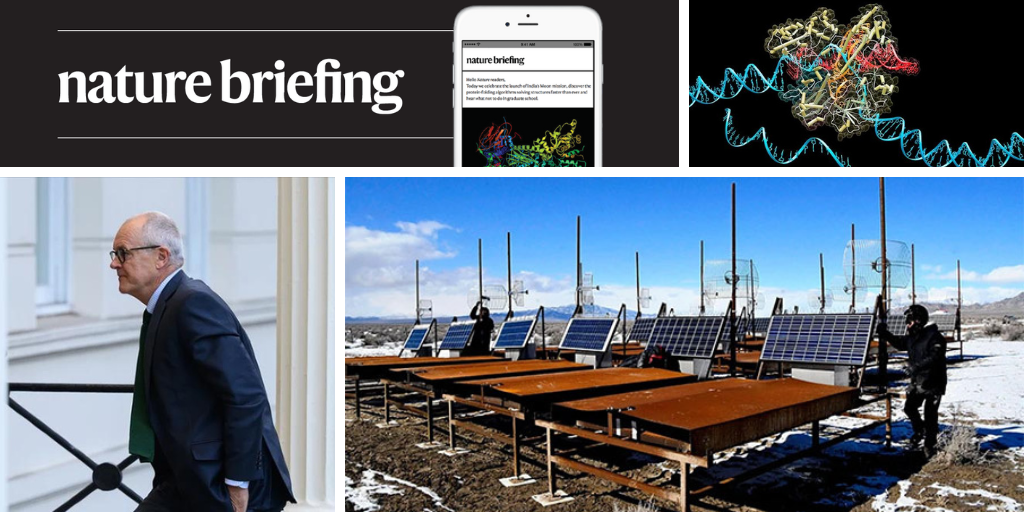Hello Nature readers, would you like to get this Briefing in your inbox free every day? Sign up here.

Researchers check the Telescope Array surface detector in the high desert in Delta, Utah, in 2019. In 2021, the Telescope Array detected the second-most energetic cosmic ray particle recorded.Credit: The Yomiuri Shimbun via AP/Alamy
Scientists have detected the highest-energy cosmic ray since the Oh-My-God particle in 1991. Cosmic rays are high-energy subatomic particles that often originate from a stellar explosion or black hole. The latest turbocharged particle, dubbed Amaterasu, seems to have come from a void-like region in space. One explanation could be that Amaterasu actually came from a different region and scientists’ models of what influences the course of cosmic rays are off. Another possibility is that the rays are produced by unknown physics.
An algorithm has found 188 genetic clusters associated with undiscovered and rare CRISPR systems, including one that targets RNA, after analysing millions of genomes. CRISPR–Cas9 is best known as a tool for editing DNA, but its natural function is as part of the immune system that helps certain microorganisms to fight off viruses. Some of the new systems could eventually be adapted into genome-editing, diagnostic or research tools.
UK politicians didn’t have the necessary scientific knowledge to understand research-based advice during the COVID-19 pandemic, a public inquiry into the country’s response to the crisis has heard. Then-chief scientific adviser Patrick Vallance said that then-prime minister Boris Johnson struggled to understand data shown in graphs. One difficulty was that the evidence sometimes changed quickly, says virologist Shahid Jameel. “Science is a process, which most people, including politicians — and some scientists — do not understand.”
Features & opinion
The debacle that has played out at OpenAI over the past week has highlighted concerns that commercial forces are acting against responsible development of artificial intelligence (AI). The company that built ChatGPT suddenly fired its co-founder and chief executive Sam Altman, only to reinstate him five days later, after staff revolted. Sarah Myers West at the AI Now Institute, a policy-research organization, is among those who worry that AI products are appearing before anyone fully understands their behaviour, uses and misuses. For too long, regulators have taken a casual approach with the companies that wield most AI power, she points out. “We need to start by enforcing the laws we have right now.”
Tornadoes, earthquakes, wildfires and other dangerous environmental events don’t have to lead to death and destruction, writes a group of disaster specialists. One of the lessons they drew from looking at examples of disasters avoided is an understanding that disasters often result when people are forced to live and work in harm’s way. Short-term actions such as evacuation and sheltering can mitigate the immediate consequences, and realistic and achievable targets are important in long-term planning.
A tourist demands to explore a historic site off the beaten track in the latest short story for Nature’s Futures series.
Poliovirus could be eradicated within three years. But eradication isn’t the same as extinction. To prevent the disease from making a comeback, countries are screening wastewater for signs of the virus. And vaccination programmes need to continue, which requires the live virus to be preserved — a containment nightmare. “We need to find ways of making vaccines without using live virus,” science journalist Aisling Irwin tells the Nature Podcast. “There is some really exciting work going on with virus-like particles and mRNA vaccines.”
Nature Podcast | 22 min listen
Subscribe to the Nature Podcast on Apple Podcasts, Google Podcasts or Spotify, or use the RSS feed.
This week, Leif Penguinson is exploring the Las Angustias ravine on La Palma, Spain. Can you find the penguin?The answer will be in Monday’s e-mail, all thanks to Briefing photo editor and penguin wrangler Tom Houghton.
This newsletter is always evolving — tell us what you think! Please send your feedback to briefing@nature.com.
Thanks for reading,
Katrina Krämer, associate editor, Nature Briefing
Want more? Sign up to our other free Nature Briefing newsletters:
• Nature Briefing: AI & Robotics — 100% written by humans, of course
• Nature Briefing: Anthropocene — climate change, biodiversity, sustainability and geoengineering
• Nature Briefing: Cancer — a weekly newsletter written with cancer researchers in mind
• Nature Briefing: Translational Research covers biotechnology, drug discovery and pharma

